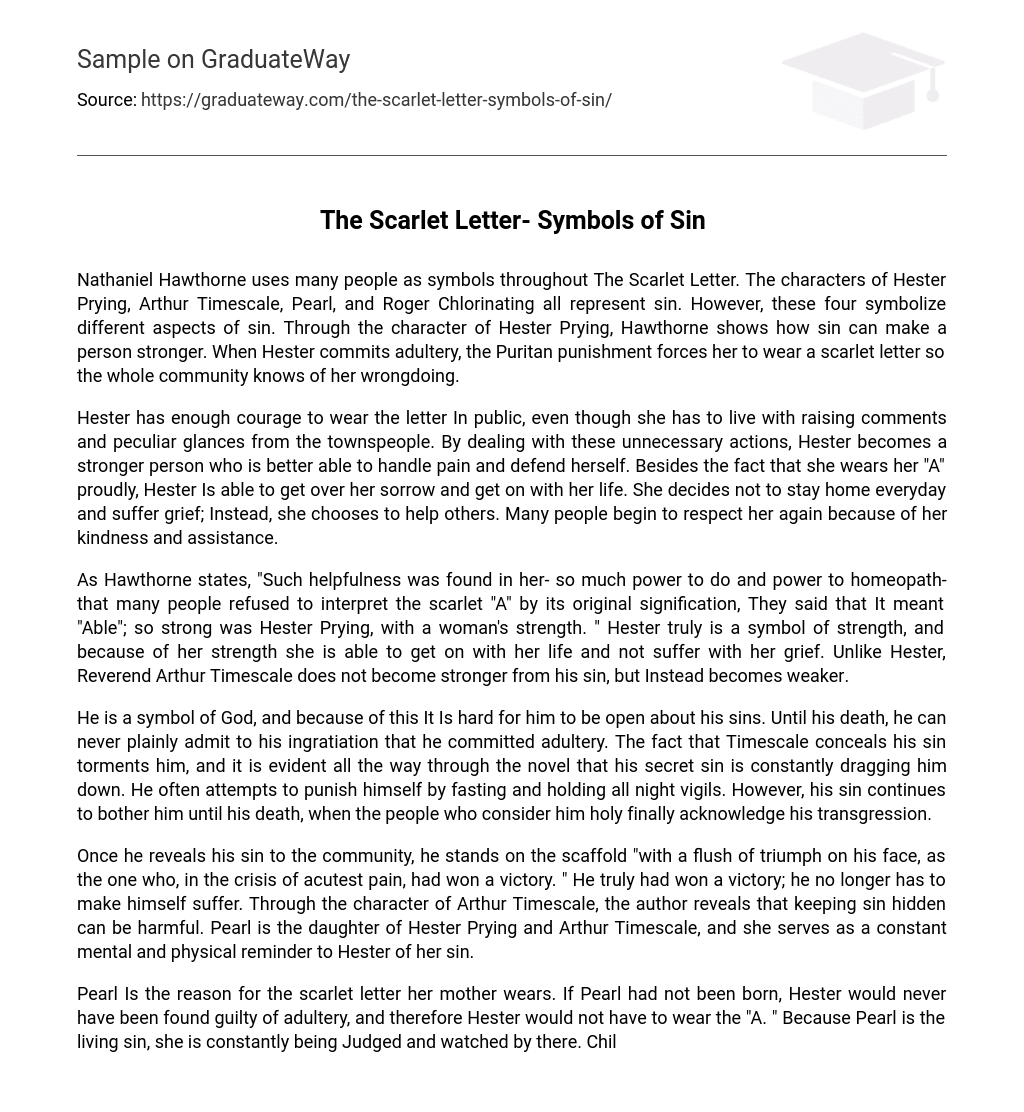Nathaniel Hawthorne uses many people as symbols throughout The Scarlet Letter. The characters of Hester Prying, Arthur Timescale, Pearl, and Roger Chlorinating all represent sin. However, these four symbolize different aspects of sin. Through the character of Hester Prying, Hawthorne shows how sin can make a person stronger. When Hester commits adultery, the Puritan punishment forces her to wear a scarlet letter so the whole community knows of her wrongdoing.
Hester has enough courage to wear the letter In public, even though she has to live with raising comments and peculiar glances from the townspeople. By dealing with these unnecessary actions, Hester becomes a stronger person who is better able to handle pain and defend herself. Besides the fact that she wears her “A” proudly, Hester Is able to get over her sorrow and get on with her life. She decides not to stay home everyday and suffer grief; Instead, she chooses to help others. Many people begin to respect her again because of her kindness and assistance.
As Hawthorne states, “Such helpfulness was found in her- so much power to do and power to homeopath- that many people refused to interpret the scarlet “A” by its original signification, They said that It meant “Able”; so strong was Hester Prying, with a woman’s strength. ” Hester truly is a symbol of strength, and because of her strength she is able to get on with her life and not suffer with her grief. Unlike Hester, Reverend Arthur Timescale does not become stronger from his sin, but Instead becomes weaker.
He is a symbol of God, and because of this It Is hard for him to be open about his sins. Until his death, he can never plainly admit to his ingratiation that he committed adultery. The fact that Timescale conceals his sin torments him, and it is evident all the way through the novel that his secret sin is constantly dragging him down. He often attempts to punish himself by fasting and holding all night vigils. However, his sin continues to bother him until his death, when the people who consider him holy finally acknowledge his transgression.
Once he reveals his sin to the community, he stands on the scaffold “with a flush of triumph on his face, as the one who, in the crisis of acutest pain, had won a victory. ” He truly had won a victory; he no longer has to make himself suffer. Through the character of Arthur Timescale, the author reveals that keeping sin hidden can be harmful. Pearl is the daughter of Hester Prying and Arthur Timescale, and she serves as a constant mental and physical reminder to Hester of her sin.
Pearl Is the reason for the scarlet letter her mother wears. If Pearl had not been born, Hester would never have been found guilty of adultery, and therefore Hester would not have to wear the “A. ” Because Pearl is the living sin, she is constantly being Judged and watched by there. Children ridicule Pearl, and others keep a careful watch on her. Governor Bellingham keeps watch on Pearl, and at one point in the book he wants to take her away from Hester.
He says that Pearl, because of Hester, is “In the dark as to her 1 OFF successful, Governor Bellingham tries to remove Pearl from the guidance of her mother. Pearl also acts in ways that cause her mother stress, and she often nags Hester about her “A. ” For example, one time Pearl throws rocks at her mother’s scarlet letter, and another time Pearl makes her own “A” out of seaweed. By acting eke this and doing these things, she reminds Hester of her scarlet letter. Pearl is the living scarlet letter, and she will not let her mother forget about her sin.
Although Roger Chlorinating does not commit one great sin like other characters, Hawthorne uses him to teach the reader that several lesser sins can be greater than single great wrongdoing. Throughout the novel, Chlorinating commits several acts of misconduct. His lack of sensitivity is shown in choosing such a young woman as his bride, his lack of chivalry is shown when he sends his wife alone to Boston, his jack of kindness is shown when he does not contact his wife for two years, and his lack of sympathy is shown when he chooses to hide his identity and change his name.
Despite all these smaller sins, Clownishness’s greatest sin is the torture and manipulation of Arthur Timescale. Chlorinating is a “leech,” one who sucks all the life out of his victim, Timescale. Clownishness’s whole reason to live is to make Timescale suffer, and soon after the death of the minister, Chlorinating also dies. He dies because, as Hawthorne states, “there was no more Devil’s work on earth for IM to do. Many smaller sins can be worse than a single sin, and Hawthorne uses Roger Chlorinating as an example of this. The Scarlet Letter, a novel written by Nathaniel Hawthorne, contains many characters that all act as symbols of sin. Hester Prying represents how sin can make one stronger, and Arthur Timescale symbolizes how hidden sins can cause harm. Pearl serves as a reminder of the scarlet letter to her mother, and Roger Chlorinating as an example of how many smaller transgressions can add up to be greater than a single sin.





